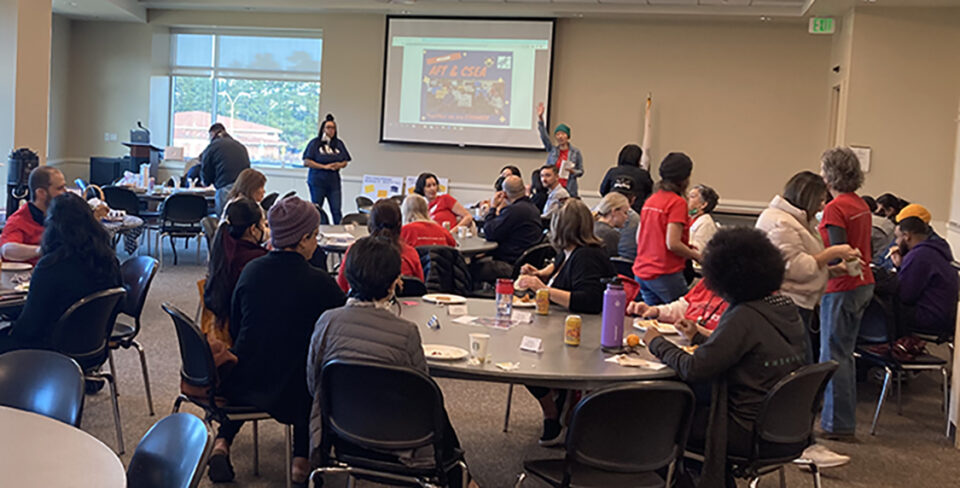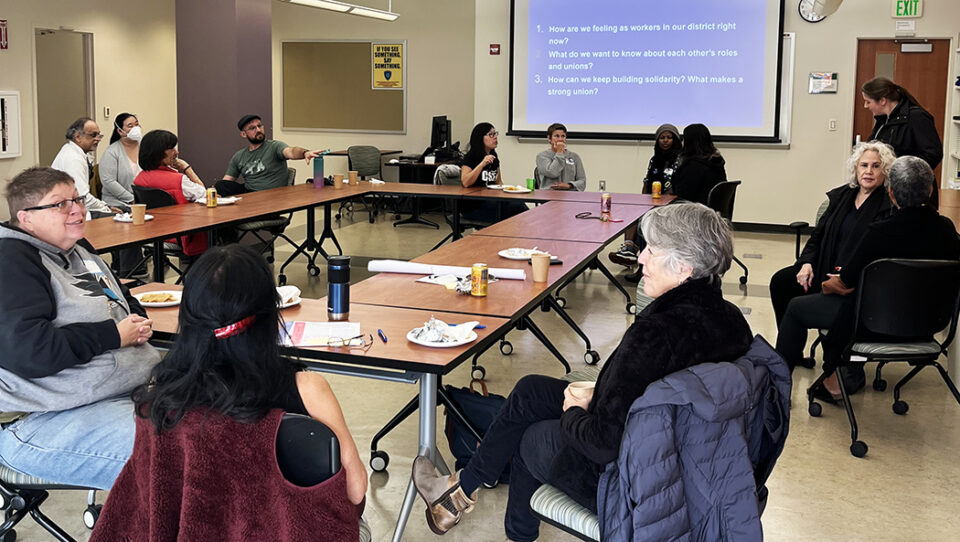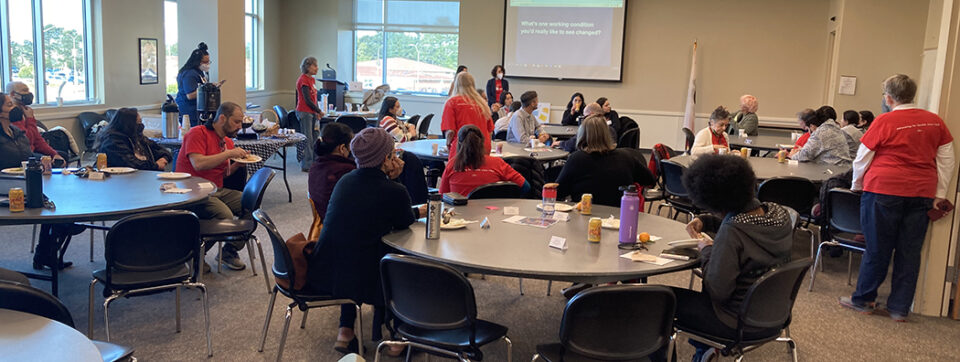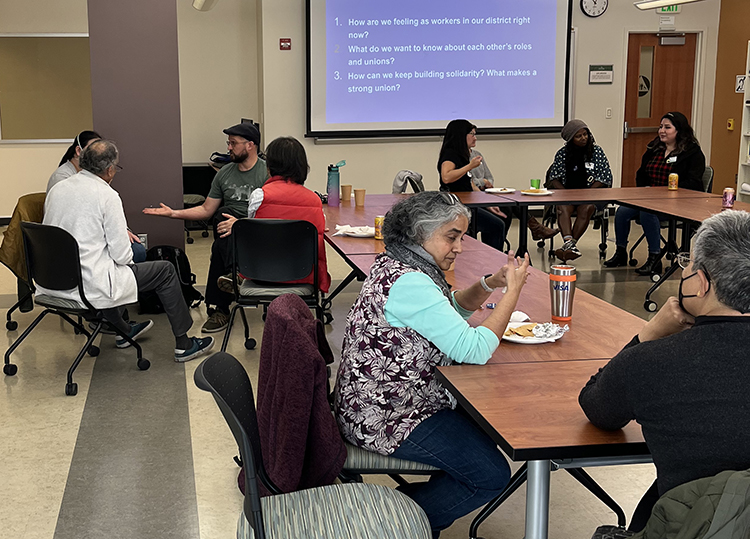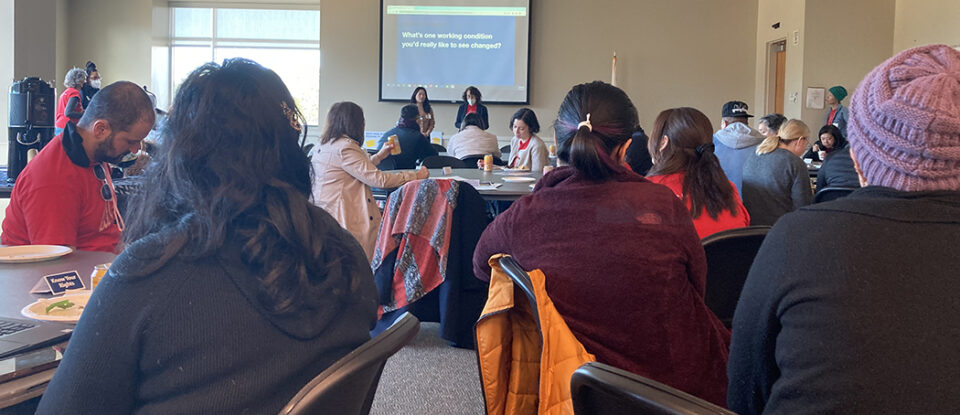Viewpoint
Dual Enrollment: A Bridge to College or a Highway Right Past Us?
By Tim Maxwell, CSM, English
As reported in the L.A. Times on November 18th, interim California Community Colleges Deputy Chancellor Lizette Navarette told a state Assembly hearing, “What we’ve seen is that higher education as a whole has been disrupted forever…We gave [them] a taste of what a flexible, adaptive education meant…[now they] will no longer want something that looks like the education they received before.”
She is voicing that steep declines in enrollment necessitate a radical overhaul of higher education. If we don’t act now to meet students where they are, she and others believe, the California Community College system, the largest, cheapest, and most democratic system of education in the country will collapse.
|
“Dual Enrollment, the initiative that promotes outsourcing of community college credit to high schools, is by far the most serious threat proposed so far, both to our students and to our jobs”
|
The threat to the system is real, but not, as she implies, primarily from students’ changing tastes, our failures as educators, or our unwillingness to adapt, but from the very measures they disingenuously claim will salvage a broken and increasingly irrelevant system. Restricting course repeatability, insisting on full classes, pushing for online and high-flex courses, and “accelerating” students with AB 705 and other measures, all prioritize access and completion–a more efficient and less costly “pathway” through college–over learning–the kind that demands a student’s full attention and which, increasingly, is the privilege of those with means and social capital. And, yet another of these measures, Dual Enrollment, the initiative that promotes outsourcing of community college credit to high schools, is by far the most serious threat proposed so far, both to our students and to our jobs.
Dual Enrollment is growing rapidly in our District
In the coming years, according to the Dual Enrollment Masterplan, the administrations of the three colleges, with the support of the Board, plan to expand our CCAP partnerships to all 15 area high schools, continuation schools, and adult schools. The short-term goal is to increase District Dual Enrollment participation from 3,600 students this year to 7000 in the 2023-24 year, or 48% of juniors and seniors. Whereas Skyline enrolled 2,669 in 2020-21, CSM, which enrolled just 129 in that year, is expected to match Skyline at 3,000 in the next academic year with Cañada increasing its share to 1,000. These targets are extraordinarily ambitious, especially without the full and fully-informed buy-in of the faculty in all three colleges.
“We” are committed, our district and college administrators claim, to “reimagining the student journey… [as] it is our moral imperative to create college pathways for all students so that they experience a liberatory education.” In other words, the education we have been offering has not only failed as a means for students to transform their lives and achieve their dreams, it is holding them back–and DE will free them. Their vision seems to be in line with that of rural Kern County, where in 2021, The Bakersfield Californian reports, 102 students graduated from high school with an AA in Communications–the fruits of an effort to “knock down barriers to make it easier for students …who want to create their own pathway…saving years of college and debt.” On the surface, especially in a rural county like Kern, this appears to be a triumph, but it doesn’t take into account how these students will perform beyond their AAs. With its own College and Career Access Partnerships (CCAPs) with local high schools, SMCCCD–responding to AB 288, which allows for DE, and moves by districts statewide and nationally–is using the decline in enrollment and especially equity concerns as pretexts for a dramatic restructuring of the system that would, in effect, merge area high schools and community colleges–what former Half Moon Bay High School District superintendent Jane Yuster described as part of a “move to the K-14 model.” In the scheme, students can take up to 15 credits per term of college credit which also count toward their high school diplomas–all without ever having to leave their high school. Dual Enrollment students miss out on both an actual high school experience and a college one.
Dual Enrollment: Less is More
It is urgent that we consider the implications of this radical program. DE presumes that less is more: less time in college classrooms, less college instruction, less formative campus life, less skills instruction, and less preparation for the challenges of upper division coursework at four-year institutions. Do students–especially those from underrepresented groups struggling to even conceive of themselves as college students–need less college education to succeed and not more? How quickly–and for how little–the designers of DE seem to be asking, can we move young learners along to their “real lives” as workers and consumers? In the DE Master Plan, it states “[we have] an equity imperative as we work to increase college access and completion, specifically among students who may not have considered post-secondary education as a viable option,” purporting that DE is part of our commitment to equity, a promise of more access and more “momentum for community college-bound high school students” to cross a “bridge to engagement with our campus.” Their moral claim that the diminishment of a community college education will somehow improve it is weak at best, despite analyses about percentage gains in “completion” for a cohort that has already been culled by AB 705. Are we building a bridge for students or a highway on which they speed right past us–and without experiencing the transformative education we know we can provide them?
The harmful effects of these economies and efficiencies will be felt even more by those whom it is claimed it will help. Some instructors report that the majority of students in their classes are “woefully unprepared and immature” and that as the stronger students thrived, others stopped attending or simply were not able to do the work. Some students were simply “placed” in these classes by their high school counselors who did not fully inform them of what they would be getting into by taking a college course. These students, many of whom I imagine are students our district claims to be targeting with Dual Enrollment, may not be aware of the additional challenges of college-level courses. Immersed in the culture of high school and lacking clear goals and sufficient family resources or the kind of support they would receive at CSM, they risk earning poor grades, which, unlike their high school grades, will remain tattooed on their transcripts wherever they may go. Far from providing them with momentum, a low GPA, which is indelible proof of their immaturity and unpreparedness, could cause them additional self-doubt as well as dilute their future successes. David Laderman, Professor of Film at CSM, recently passed on that he’d had a student applying for the Honors Project asking for an exception, as his GPA was low due to a 2019 Dual Enrollment class he’d done poorly in. Laderman has had several other students come to him, concerned about their low GPAs because of Dual Enrollment coursework taken–before they were ready for it.
Who really benefits from Dual Enrollment?
In truth, Dual Enrollment may end up easing the way for students with the means and the social capital more than it does those whom it is supposedly meant to serve. Even if studies show DE moves some of these traditionally underrepresented groups more speedily to certificate or degree completion, nationwide black and brown students are less well represented than others.This is true in SMCCCD as well, where more than 50% of those currently enrolled in DE classes are white or Asian, already showing the program is primarily serving different groups that it is supposedly intended for. DE instructors I have spoken with, but who choose to remain anonymous, have described some of their students as hardworking, competent, and even “philosophical”; it was evident to the instructors, however, that few of these students were bound for College of San Mateo. Some students even admitted they had made a practical decision to shave off important college courses they would eventually have taken at the four-year institutions they were or would be applying to anyway. DE classes, they said, were likely to be an easier “A” than highly selective and competitive AP courses–and without the exam. Should it be our mission to provide students–advantaged or disadvantaged–with the fastest way through their educations–and perhaps past our colleges?
As our courses are outsourced to high schools, fewer students are likely to come to our campuses
And the threat is not only to our most vulnerable students; our livelihood as college educators also faces potential catastrophe. Inevitably, as our credit is outsourced to high schools, we will see declines (not increases as they claim) in students who set foot on our campuses, resulting in a further enrollment decline that will limit full-time on-campus opportunities. Among our full-time and senior part-time faculty, we have neither the workforce nor the desire (in most cases) to abandon our current jobs and our campus to dedicate ourselves to going on the road. What would the incentive be for any of us to take on the challenges of misaligned schedules, travel times between campuses, inadequate conditions (including office space on each campus), and supplementary preparation for open enrollment classes? Even if some of us were to opt to invest ourselves in a new career teaching high school students, with the early goal of reaching 7000 of these students in sections of 25 students each, we would have to offer 280 remote sections. If each full-time instructor dedicated approximately half of their load to these offsite “opportunities,” 140 of us would need to participate, leaving too few of us to meet the demands of our college students; this would impact our classes and require the hiring of even more part-timers. CSM professors teaching Dual Enrollment History, DGME, and COMM have all reported negative or even disastrous experiences. It is highly unlikely that tenured faculty or part-timers with seniority would teach these classes, so who would?
As the remote “campus” grows and our student body shrinks, an ill-defined “dual faculty” system would have to emerge. Regular district faculty may be required to join underpaid, under-benefitted part-time faculty–many of them likely to be hired specifically for these duties and who might never be offered a section on campus, compelling “freeway fliers” to freeway-fly between multiple campuses as well as other districts. And, of course, high school teachers, meeting only minimum qualifications, would teach most of these courses and without being well integrated into corresponding colleges and departments.
By no means do I mean any disrespect for high school teachers, many of whom provide inspired and inspiring teaching to their students, but members of this corps would be teaching college courses without being hired through the normal processes (unless that will become yet another duty thrust upon us), without college-specific professional development, without regular peer evaluation, without the culture of excellence that emerges from working together as part of a dedicated faculty. What kind of disrespect is the administration showing our faculty by claiming that this shadow faculty could offer a truly equivalent education, not one that merely minimally qualifies? What–other than our course outlines–will make these Cañada, CSM, or Skyline courses? Our faculties will no longer be true communities of practice; instead, we will be part of a disparate team of retention specialists, high school counselors, specialized marketing teams to target students and their families, and, as they promise, a new dean.
In a conversation earlier this semester with Andrea Vizenor, Director of Strategic Initiative and Economic Development, who has been put in charge of DE’s expansion, I mentioned that rather than expanding to the high schools, we could increase our enrollment, utilize our beautiful campus, and facilitate students’ progress toward their completion goals by simply driving them to campus.
“Far too expensive,” she replied.
A hostile attack on the nation’s largest and most democratic education system
The State Chancellor’s office and community college districts, hungry to maintain high enrollments in order to maintain their bottom line, are proposing a hostile attack on the nation’s largest and most democratic education system. They seek a seemingly unlimited expansion of apportionment by capturing an enormous, almost untapped, and potentially unprepared population of students at relatively little cost rather than compete with both universities and the fluctuating economy for adult learners. The heartbreaking stress caused to many of our students by the myriad inequities in our state and our society more generally cannot be addressed through what are, in effect, cost-cutting measures. It is especially cynical that this assault should come disguised in the Trojan horse of equity, this dubious claim that we are somehow serving the less-advantaged students by providing them with less education–both in quantity and quality.
In his interview to be our next chancellor, Santanu Bandyopadhyay sang the praises of Dual Enrollment, defining the success of the initiative “up and down the state” but highlighting Kern County, where high school students are already earning diplomas and AA degrees at the same time, as having had the “most success” because they had reached 8000 DE students, as if the quantity were the only important measure. He went on to say he was exploring the idea of enrolling all high school students in their area community colleges by default.
Is this the future we choose?
Do you have another perspective on dual enrollment? The Advocate would like to encourage readers to comment on this article on AFT 1493’s Discord server. Click here to comment.
How to join Discord: (1) create an account and download the app. (2) request to be added to our AFT1493 server. Want to learn more? See this beginner’s guide to Discord for more information.
We would also like to publish a range of views on the important topic of dual enrollment in the next issue. Please submit your article to Advocate Editor Eric Brenner at brenner@aft1493.org

